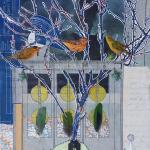 I heard a story once about a Native American elder who was asked how she had become so wise, so happy, and so respected. She answered: “In my heart, there are two wolves: a wolf of love and a wolf of hate. It all depends on which one I feed each day.”
I heard a story once about a Native American elder who was asked how she had become so wise, so happy, and so respected. She answered: “In my heart, there are two wolves: a wolf of love and a wolf of hate. It all depends on which one I feed each day.”
This story always gives me a little shiver. It’s both humbling and hopeful. First, the wolf of love is very popular, but who among us does not also harbor a wolf of hate? We can hear its snarling both far away in distant wars and close to home in our own anger and aggression, even toward people we love. Second, the story suggests that we each have the ability—grounded in daily actions—to encourage and strengthen empathy, compassion, and kindness while also restraining and reducing ill will, disdain, and aggression.
In my previous post, I explored some of the basis, in the brain, of romance and love. In this one, let’s consider the dark side of bonding: how attachment to “us” both fuels and has been nurtured by fearful aggression toward “them.” Acknowledging the reality of the wolf of hate, and understanding its origins, powers, and “food,” are vital steps toward restraining that wolf, and thereby making our homes, workplaces, and world safer and more loving places to be. (For more on this subject, and how to nourish the wolf of love and tame the wolf of hate, see my book, Buddha’s Brain: The Practical Neuroscience of Happiness, Love, and Wisdom, from which much of this post is adapted.)
The Evolution of Hate
Economic and cultural factors certainly play a role in human aggression, whether in thoughts, words, or deeds. Additionally, recent studies are shedding light on the effects of biological evolution, driven by the “reproductive advantages” of anger, prejudice, and violence.
For millions of years, our ancestors were exposed to starvation, predators, and disease. Making matters worse, climactic ups and downs brought scorching droughts and freezing ice ages, intensifying the competition for scarce resources. Altogether, these harsh conditions kept hominid and human population levels essentially flat despite potential growth rates of about 2 percent per year (Bowles 2006). (It’s not common to cite references in blog posts, but this general subject is often so controversial, for obvious reasons, that I thought you might be interested in some of these studies.)
In those tough environments, it was reproductively advantageous for our ancestors to be cooperative within their own band but aggressive toward other bands (Choi and Bowles 2007). Cooperation and aggression evolved synergistically: bands with greater cooperation were more successful at aggression, and aggression between bands demanded cooperation within bands (Bowles 2009).
The result was ubiquitous and commonplace violence. For example, most modern hunter-gatherer bands—which offer strong indications of the social environments in which our ancestors evolved—have engaged in ongoing conflicts with other groups. While these skirmishes lacked the shock and awe of modern warfare, they were actually much more lethal: roughly one in eight hunter-gatherer males died from them, compared to the one in a hundred men who died from the wars of the twentieth century (Bowles 2006; Keeley 1997).
The Angry Brain
Much like cooperation and love draw on multiple neurological systems, so do aggression and hate:
• Much if not most aggression is a response to feeling threatened—which includes even subtle feelings of unease or anxiety. Because the amygdala – the alarm bell of the brain – is primed to register threats and is increasingly sensitized by what it “perceives,” many people feel increasingly threatened over time. And thus increasingly aggressive.
• Once the fight-or-flight sympathetic nervous system (SNS) activate in consort with the hypothalamic-pituitary-adrenal axis (HPAA), if you’re going to fight instead of flee, blood surges to your arm muscles for hitting, piloerection (goose bumps) makes your hair stand up to make you look more intimidating to a potential attacker or predator, and the hypothalamus can trigger rage reactions.
• Aggressiveness correlates with high testosterone—in both men and women—and low serotonin.
• Language systems in the left frontal and temporal lobes work with visual-spatial processing in the right hemisphere to categorize others as friends or foes, persons or nonentities who can be exploited, enslaved, raped, or murdered.
• “Hot” aggression—with lots of SNS/HPAA activation— often overwhelms prefrontal regulation of emotions. “Cold” aggression involves little SNS/HPAA activation and draws on sustained prefrontal activity; consider the proverb “revenge is a dish best served cold.”
Locked and Loaded Today
Our brains still possess these capabilities and inclinations. They’re at work in schoolyard cliques, office politics, and domestic violence. (Healthy competition, assertiveness, and fierce advocacy for people and causes you care about are very different from hostile aggression.)
On a larger scale, our aggressive tendencies fuel prejudice, oppression, ethnic cleansing, and war. Often these tendencies are manipulated, such as by the demonization of “them” in the classic justification for strong-father, authoritarian control. But those manipulations wouldn’t be nearly so successful if it weren’t for the legacy of between-group aggression in our evolutionary history.
What’s Left Out
There’s a Zen saying, Nothing left out. Nothing left out of your awareness, nothing left out of your practice, nothing left out of your heart. As the circle shrinks, the question naturally arises: What is left out? It could be people on the other side of the world with a different religion, or people next door whose politics you don’t like. Or relatives who are difficult, or old friends who hurt you. It could be anyone you regard as less than you or as merely a means to your ends.
As soon as you place anyone outside of the circle of “us,” the mind/brain automatically begins to devalue that person and justify poor treatment of him (Efferson, Lalive, and Feh 2008). This gets the wolf of hate up and moving, only a quick pounce away from active aggression. Pay attention to the number of times a day you categorize someone as “not like me,” particularly in subtle ways: not my social background, not my style, and so on. It’s startling how routine it is. See what happens to your mind when you consciously release this distinction and focus instead on what you have in common with that person, on what makes you both an “us.”
Loving the Wolf of Hate
Ironically, one answer to “What’s left out?” is the wolf of hate itself, which is often denied or minimized. For example, it makes me uncomfortable to admit how good it feels when the hero kills the bad guy in a movie. Like it or not, the wolf of hate is alive and well inside each one of us. It’s easy to hear about a dreadful murder across the country or terrorism and torture across the world—or milder forms of everyday mistreatment of others close at hand— and shake your head, thinking, “What’s wrong with them?” But them is actually us. We all have the same basic DNA. It is a kind of ignorance—which is the root of suffering—to deny the aggression in our genetic endowment. In fact, as we’ve seen, intense intergroup conflict aided the evolution of within-group altruism: the wolf of hate helped give birth to the wolf of love.
The wolf of hate is deeply embedded both in the human evolutionary past and in each person’s brain today, ready to howl at any threat. Being realistic and honest about the wolf of hate—and its impersonal, evolutionary origins—brings self-compassion. Your own wolf of hate needs taming, sure, but it’s not your fault that it lurks in the shadows of your mind, and it probably afflicts you more than anyone else. Additionally, acknowledging the wolf of hate prompts a very useful caution when you are in situations— arguing with a neighbor, disciplining a child, reacting to criticism at work—in which you feel mistreated and revved-up, and that wolf begins to stir.
When you’re watching the evening news—or even just listening to children bicker—it can sometimes seem like the wolf of hate dominates human existence. Much like spikes of SNS/HPAA arousal stand out against a backdrop of resting-state parasympathetic activation, dark clouds of aggression and conflict compel more attention than the much larger “sky” of connection and love through which they pass. But in fact, most interactions have a cooperative quality. Humans and other primate species routinely restrain the wolf of hate and repair its damage, returning to a baseline of reasonably positive relationships with each other (Sapolsky 2006). In most people most of the time, the wolf of love is bigger and stronger than the wolf of hate.
Love and hate: they live and tumble together in every heart, like wolf cubs tussling in a cave. There is no killing the wolf of hate; the aversion in such an attempt would actually create what you’re trying to destroy. But you can watch that wolf carefully, keep it tethered, and limit its alarm, righteousness, grievances, resentments, contempt, and prejudice. Meanwhile, keep nourishing and encouraging the wolf of love.
We’ll explore how to do this in the next several weeks worth of posts on this blog.
References:
Bowles, S. 2006. Group competition, reproductive leveling, and the evolution of human altruism. Science 314:1569-1572.
Bowles, S. 2009. Did warfare among ancestral hunter-gatherers affect the evolution of human social behaviors? Science 324:1293- 1298.
Choi, J. and S. Bowles. 2007. The coevolution of parochial altruism and war. Science 318:636-640.
Efferson, C., R. Lalive, and E. Feh. 2008. The coevolution of cultural groups and ingroup favoritism. Science 321:1844-1849.
Keeley, L. H. 1997. War Before Civilization: The Myth of the Peaceful Savage. New York: Oxford University Press.
Sapolsky, R. M. 2006. A natural history of peace. Foreign Affairs 85:104-121.
****************
 Rick Hanson, Ph.D., is a neuropsychologist and founder of the Wellspring Institute for Neuroscience and Contemplative Wisdom. A summa cum laude graduate of UCLA, he teaches at universities and meditation centers in Europe, Australia, and North America. His work has been featured on the BBC and in Consumer Reports Health, U.S. News and World Report, and other major magazines.
Rick Hanson, Ph.D., is a neuropsychologist and founder of the Wellspring Institute for Neuroscience and Contemplative Wisdom. A summa cum laude graduate of UCLA, he teaches at universities and meditation centers in Europe, Australia, and North America. His work has been featured on the BBC and in Consumer Reports Health, U.S. News and World Report, and other major magazines.
Rick’s most recent book is Buddha’s Brain: The Practical Neuroscience of Happiness, Love, and Wisdom (with Rick Mendius, M.D.; Foreword by Dan Siegel, M.D. and Preface by Jack Kornfield, Ph.D.), which has been praised by numerous scholars, therapists, and teachers, including Tara Brach, Ph.D., Roger Walsh, Ph.D., Sharon Salzberg, and Fred Luskin, Ph.D., and is being published in nine additional languages. An authority on self-directed neuroplasticity, he edits the Wise Brain Bulletin, and his articles have appeared in Tricycle Magazine, Insight Journal, and Inquiring Mind; his Your Wise Brain blog is on Huffington Post, Psychology Today, and other major websites. He has a chapter – 7 Facts about the Brain That Incline the Mind to Joy – in Measuring the Immeasurable, as well as several audio programs with Sounds True. His first book was Mother Nurture: A Mother’s Guide to Health in Body, Mind, and Intimate Relationships (Penguin, 2002)
Rick is currently a trustee of Saybrook University. He also served on the board of Spirit Rock Meditation Center for nine years, and was President of the Board of FamilyWorks, a community agency. He began meditating in 1974, trained in several traditions, and leads a weekly meditation gathering in San Rafael, CA. He enjoys rock-climbing and taking a break from emails. He and his wife have two children. For more information, please see his full profile at www.RickHanson.net. You can find him on the social web at http://www.facebook.com/BuddhasBrain and http://www.YouTube.com/BuddhasBrain














